In Florida’s warm and moist climate, snakes are a common occurrence. In fact, there are 44 different species of snakes that can be found in Florida. Unfortunately, some of these species of snakes are venomous, and their bite can be painful and—if you’re particularly unlucky—deadly. No wonder that the fear of snakes, or ophidiophobia, is common.
But not all snakes are dangerous. So, how can you identify dangerous snakes? What should you do if you get bitten? And how can you get rid of venomous snakes on your property? At Critter Control of Tampa, we’ve got the answers and the snake control for when you need it.
How Dangerous Are Snakes?
There are two ways to answer this question about snake danger. To start, regardless of the type of snake you encounter: the chances of death or severe injury from being bit by a venomous snake is extremely, extremely small. The vast majority of deaths from snakebites happen to individuals who are actively trying to catch, kill, or handle a snake. As with most animals, most snakes are not aggressive towards humans, and if you don’t mess with the snake—even a venomous snake—they aren’t likely to mess with you.
But how dangerous can snakebites be? If you’re bitten by a non-venomous snake, there are very little long-term consequences. Additionally, even if you’re bitten by a venomous snake, you could experience what is called a dry bite; IE, a bite without venom.
If you are bitten and injected with venom from a venomous snake, though, the consequences can be severe. There are a wide variety of symptoms from snake bites depending on the type of snake that bites you and how much venom they inject, including:
- Sharp pain around the bite
- Redness and swelling
- Blood clotting, bleeding, and unusual blood pressure
- Nausea, vomiting, dizziness, and blurred vision
- Muscle weakness
- Death
Even though a venom-injected snake bite is a rare event, treat every snake bite as if it was a venomous bite and seek medical attention immediately.
How to Identify Dangerous Snakes
Identifying dangerous snakes can be difficult. While some snakes, like the eastern coral snake, are colorful and can be identified from a distance, many of the venomous snakes are not as easily identifiable. There are two main ways to identify dangerous snakes:
- Rattle—Though non-venomous rattlesnakes do exist, all venomous rattlesnakes have a rattle. If you can see or hear the rattle, it is most likely venomous.
- Head Shape—Venomous snakes tend to have triangular shaped heads as opposed to more oval shaped heads; venomous snakes also have pointy snouts and elliptical pupils.
- Fangs—Venomous snakes will have prominent, hinged fangs, while non-dangerous snakes do not.
Though these general rules will help you go a long ways in dangerous snake identification, you won’t always be able to accurately identify a dangerous snake, especially from a distance. And since most snake bites happen to people who provoke and/or handle snakes, we do not recommend moving in extremely close to attempt identification.
As a result, there is one method of dangerous snake identification that is foolproof: assume every snake is venomous and handle it as such. It’s better to be too safe than not safe enough.
Non-Dangerous Snakes
Most snakes in Florida are non-dangerous snakes because they are not venomous. These snakes are harmless to humans and generally hunt by constricting very small animals like frogs and rodents. Some of Florida’s common non-dangerous snakes include:
- Southern black racer
- Garter snakes
- Green snakes
- Kingsnakes
- Rainbow snakes
Types of Venomous Snakes in Florida
There are six kinds of venomous snakes in Florida. Some go by a few different names, and many of these snakes fall under the broader venomous snake group of “pit vipers.”
Eastern Coral Snake
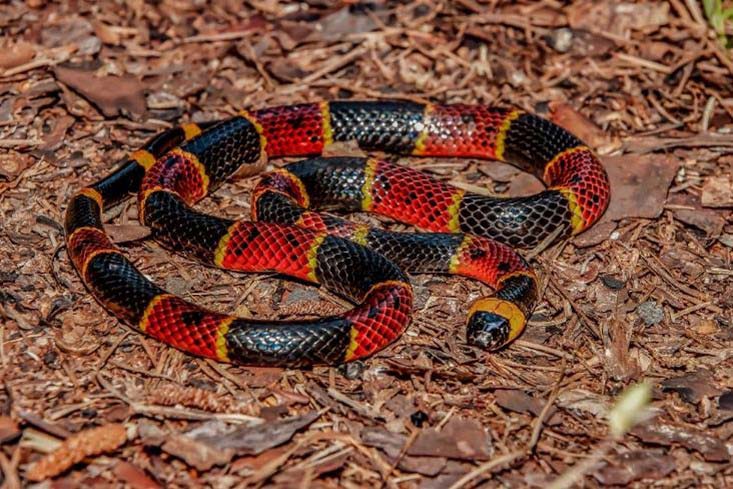
These colorful snakes feature black, red, and yellow markings. The similarly colored kingsnake also features stripes of red, yellow, and black. Coral snakes feature thin yellow stripes that surround larger red ones, while the yellow stripe of a kingsnake is surrounded by black stripes. Eastern coral snakes have potent venom, but often implement a dry bite.
Southern copperhead
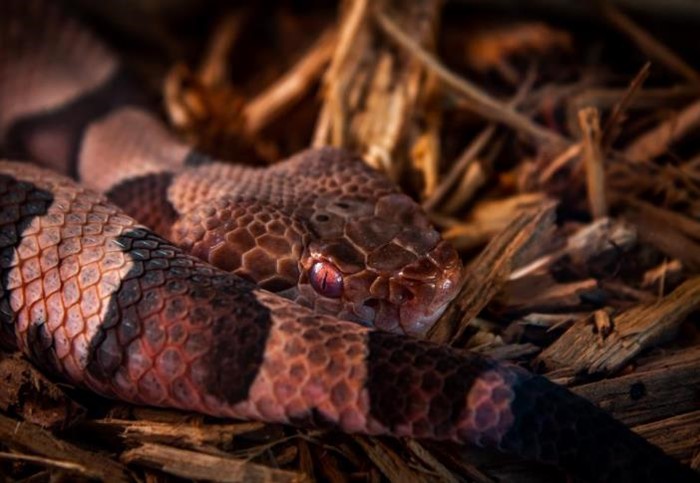
The venom from a copperhead is painful but does not tend to result in extremely serious health outcomes. As their name suggests, copperheads are copper-colored and have distinctive copper-colored eyes.
Cottonmouth
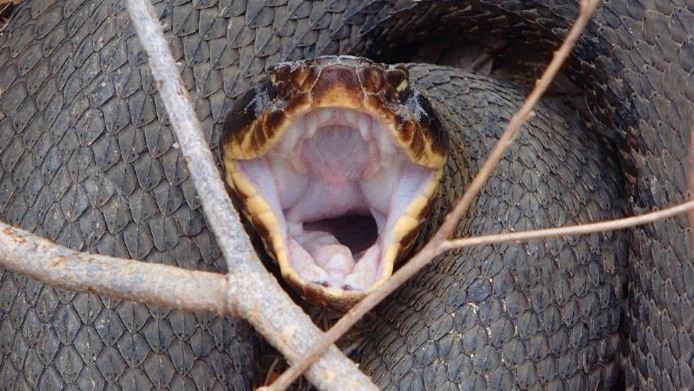
Also called water moccasins, cottonmouths are named from their distinctive cotton-colored mouth which they bare in a wide-open gape to threaten other animals (including humans). Cottonmouth bites are painful and can be very dangerous. Cottonmouths are one of the more common venomous snakes in Florida.
Eastern diamondback rattlesnake
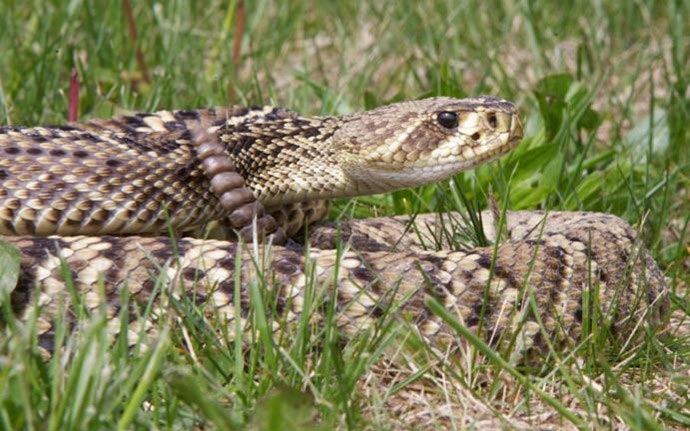
You don’t just find rattlesnakes in the deserts of the western United States. The eastern diamondback rattlesnake is a common sight in Florida. Named for the diamond pattern in their scales, the eastern diamondback is one of the largest snakes in Florida—they can grow up to six feet in length and strike up to four feet away.
Timber rattlesnake
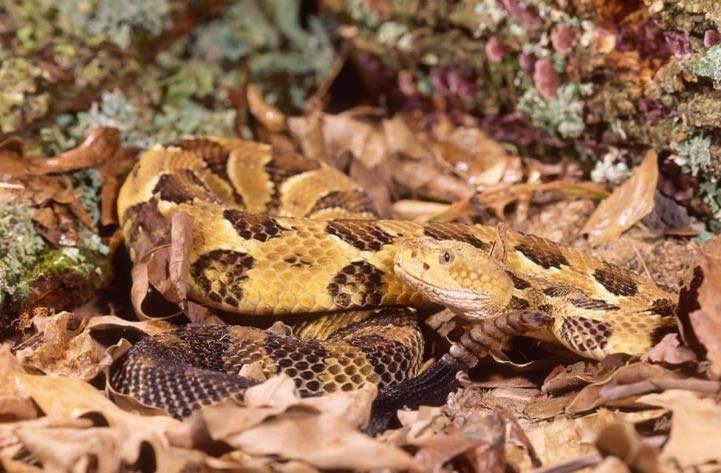
The camouflaged timber rattlesnake can be difficult to spot, especially among leaves and trees. Like the eastern diamondback, the timber rattlesnake is large. Their brown color and patterns are what make them distinct.
Dusky pygmy rattlesnake
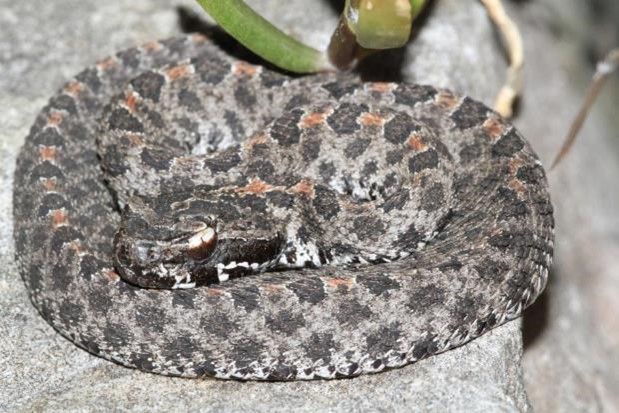
The dusky pygmy rattlesnake is a small rattlesnake that is usually less than two feet in length, though they are thick for their length. Found throughout Florida, the dusky pygmy rattlesnake is, as its name suggests, grey in color, and can have red and orange markings on its back.
Snake Pest Control for Homes and Businesses
Encountering a snake can be a harrowing experience, especially if you find a group of snakes or are bitten by one. If you’re bitten by a snake, it’s best practice to seek medical help in case that it’s a venomous one.
Still—how do you get rid of snakes on your property? The answer is simple: Critter Control of Tampa. Our experienced technicians can implement a variety of snake control solutions, whether you’re a resident or a business owner. Stop worry about snakes when there’s an alternative. Contact us online or give us a call today!






